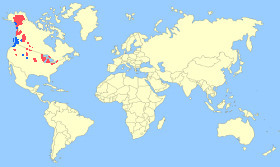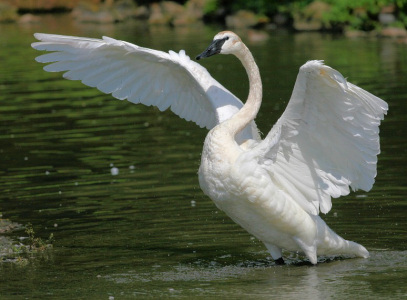Appearance: - The Trumpeter Swan has a white plumage with a black beak marked with salmon-pink along the mouth-line, the black extends from the beak to the front of the eye, the feet are usually a grey-black. The female (Pen) closely resembles the male (Cob) but is slightly smaller. The Trumpeter Swan looks similar to the Whistling Swan as both are white with a black beak and legs but the Whistling Swan is slightly smaller, has a different shaped beak and usually has a small yellow patch in front of the eye.
Size: - Typical Adult is 145-163cm (57-64in).
Food: - Mainly aquatic plants, duckweed, pondweed, but will also graze in crop fields. They will also eat animal matter such as insect larvae, worms, and molluscs.
Habitat/Range: - Lakes, rivers, ponds in north west and central North America:- mainly Alaska, and Canada and they migrate to the Pacific coast.

 Breeding Habitat/Resident,
Breeding Habitat/Resident,  Migration or Winter Area.
Migration or Winter Area.Breeding Season: - Late April to late May.
Eggs: - 4 to 7 (white colour).
Notes: - The Trumpeter Swan was heavily hunted for food and also their feathers in the 19th and early 20th century causing a severe decline in their numbers. However, they have now increased rapidly in population due to protection. One of the best ways to identify a Trumpeter Swan is by its deep trumpet-like call. The Trumpeter Swan is the heaviest living bird native to North America and is the American counterpart and a close relative of the Eurasian Whooper Swan.
Conservation status (IUCN 3.1):
Least Concern.
Classification: - Family: Anatidae,
Subfamily: Anserinae, Genus: Cygnus.



























